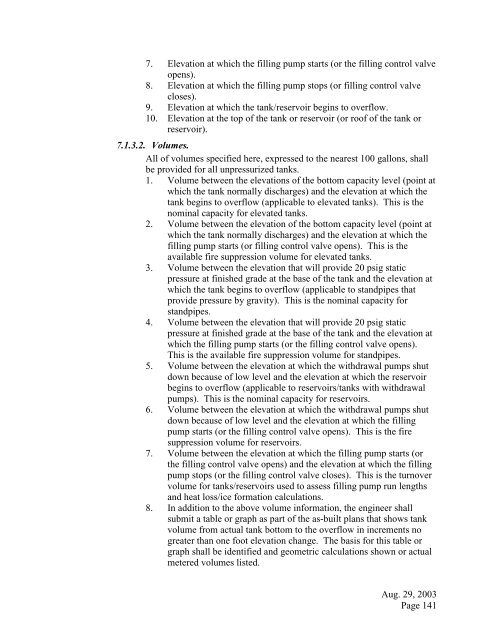Design Guide for Community Water Systems - The Water, Sanitation ...
Design Guide for Community Water Systems - The Water, Sanitation ...
Design Guide for Community Water Systems - The Water, Sanitation ...
You also want an ePaper? Increase the reach of your titles
YUMPU automatically turns print PDFs into web optimized ePapers that Google loves.
7. Elevation at which the filling pump starts (or the filling control valveopens).8. Elevation at which the filling pump stops (or filling control valvecloses).9. Elevation at which the tank/reservoir begins to overflow.10. Elevation at the top of the tank or reservoir (or roof of the tank orreservoir).7.1.3.2. Volumes.All of volumes specified here, expressed to the nearest 100 gallons, shallbe provided <strong>for</strong> all unpressurized tanks.1. Volume between the elevations of the bottom capacity level (point atwhich the tank normally discharges) and the elevation at which thetank begins to overflow (applicable to elevated tanks). This is thenominal capacity <strong>for</strong> elevated tanks.2. Volume between the elevation of the bottom capacity level (point atwhich the tank normally discharges) and the elevation at which thefilling pump starts (or filling control valve opens). This is theavailable fire suppression volume <strong>for</strong> elevated tanks.3. Volume between the elevation that will provide 20 psig staticpressure at finished grade at the base of the tank and the elevation atwhich the tank begins to overflow (applicable to standpipes thatprovide pressure by gravity). This is the nominal capacity <strong>for</strong>standpipes.4. Volume between the elevation that will provide 20 psig staticpressure at finished grade at the base of the tank and the elevation atwhich the filling pump starts (or the filling control valve opens).This is the available fire suppression volume <strong>for</strong> standpipes.5. Volume between the elevation at which the withdrawal pumps shutdown because of low level and the elevation at which the reservoirbegins to overflow (applicable to reservoirs/tanks with withdrawalpumps). This is the nominal capacity <strong>for</strong> reservoirs.6. Volume between the elevation at which the withdrawal pumps shutdown because of low level and the elevation at which the fillingpump starts (or the filling control valve opens). This is the firesuppression volume <strong>for</strong> reservoirs.7. Volume between the elevation at which the filling pump starts (orthe filling control valve opens) and the elevation at which the fillingpump stops (or the filling control valve closes). This is the turnovervolume <strong>for</strong> tanks/reservoirs used to assess filling pump run lengthsand heat loss/ice <strong>for</strong>mation calculations.8. In addition to the above volume in<strong>for</strong>mation, the engineer shallsubmit a table or graph as part of the as-built plans that shows tankvolume from actual tank bottom to the overflow in increments nogreater than one foot elevation change. <strong>The</strong> basis <strong>for</strong> this table orgraph shall be identified and geometric calculations shown or actualmetered volumes listed.Aug. 29, 2003Page 141
















